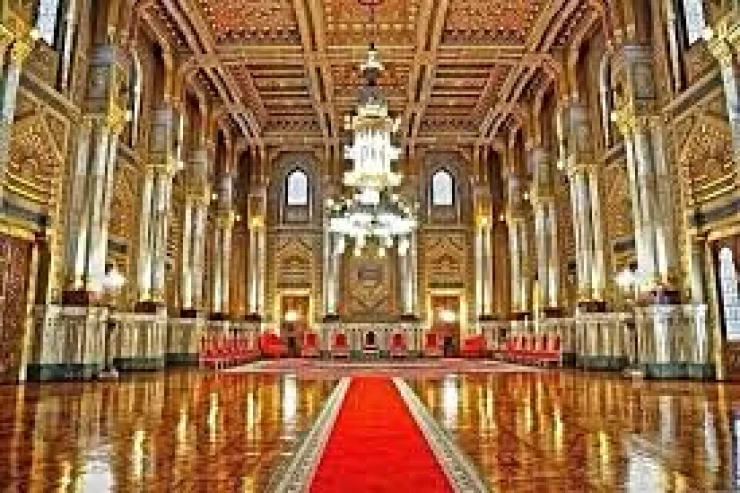
The various pyramids in Egypt
The pyramids of Egypt
The old kingdom in Egypt is distinguished as the kingdom that had built the pyramids, and everyone knows that Egypt includes 3 pyramids, but that is not true, as the ancient pharaohs constructed more than 100 pyramids in various parts of Egypt, as there are those who were destroyed in different eras and there are those who remained stable until now, the most famous of which are the pyramids of Giza and the Saqqara pyramid for King Djoser.
The pyramids were mainly used as tombs for the kings of the Old Kingdom, and this was the most unique feature of the monuments of that period, in addition to the inscriptions and graffiti that were on the temple and tomb walls.
Many things were used to construct the pyramids, but the most famous were granite and basalt, especially at the top of the pyramid.
Pyramids and their history
Djoser's pyramid
Historians consider it to be the oldest pyramid in Egypt, which was constructed by King Djoser in the form of steps that number up to 6 mastabas.
So experts said that it resembles the terraces that were in the previous dynasties more than the pyramids, and it was built of limestone as well, and its length reaches more than 160 meters, as it was affected by an earthquake that occurred in 1992, which lost some parts of it.
The step pyramid was constructed by the engineer Imhotep, who is considered the oldest engineer in history, and several other pyramids were also built in the Saqqara region, where they reached 15, such as the pyramid of Sekhmet Khet or the pyramid of Oserkaf, and even Kings Bibi I and II have pyramids there, in addition to the pyramid of Onas, and as for statues, King Djoser has a complete statue that is in the Egyptian Museum in Cairo.
Pyramids of Snefru
King Snefru is one of the most important kings of the Fourth Dynasty and its founder, and he has more than one of his pyramids. Snefru tried to construct more than one pyramid, such as the pyramid of Meidum in Beni Suef, but he built a leaning pyramid after him, which made him reconsider constructing his last pyramid, which is the Red Pyramid in Dahshur, where there were doubts about the origin of this pyramid, as a piece of limestone was discovered near it, written in hieroglyphics, one of King Snefru's nicknames.
In the Dahshur region, there are other pyramids of Sneferu, such as the White Pyramid of Amenemhat II, but it was destroyed and did not become the same form in which it was originally built, and the reason for calling it white is that the king built it from white limestone.
Just like there is a white pyramid, there is a black pyramid for King Amenemhat III, which is one of the pyramids that was destroyed and became a mountain of sand and is called black because of the appearance of this black and added mud to this pyramid as part of its construction.
There is also a pyramid of King Senwosret III, which was discovered to have been stolen by ancient thieves in the eighties of the last century by the French professor Jacques de Morgan. This pyramid was also different from the others in that it was built with adobe bricks and limestone.
The king's chamber contained a dagger, and the king's private coffin was made of granite, but it was empty, so historians may suggest that the king was not buried in this pyramid, but what was found were some things of the mother of King Senwosret III, Khenmet Nefer, who is also the wife of Senwosret II.
Giza pyramids
The Great Pyramid
The Great Pyramid was constructed during the reign of King Khufu, which is considered one of the seven marvels of the ancient world and also the only one that remains completely intact.
So it's a great construction, as it was built by the engineer Ham Iono, who has a large statue that is currently in Germany.
This great pyramid was called the horizon of Khufu, as it was considered a place that led to the god Ra. King Khufu considered himself the god Ra, and he was the first king to consider himself a god. After him came Khafre and Mankhaura, who did the same thing and considered themselves gods.
Over time, parts of the pyramid have been destroyed by weathering and erosion.
The Middle Pyramid of Khafre
Khafre built this pyramid, which is smaller than his father's pyramid. A distinguishing feature is that this pyramid still retains part of its outer layer towards the top. Internally, the pyramid was provided with a downward-sloping passage which leads to the burial chamber, now empty. Indeed, we call the Pyramid of Cheops great; however, the Middle Pyramid too came close to the greatness of a true pyramid; hence, Khafre referred to it as a Great Pyramid.
Khafre is known for building the Sphinx; although historians are divided about the real owner of the Sphinx, archaeologists suggest that it is closer to the second pyramid and is located on the same road leading to the mortuary temple of Khafre.
The smaller pyramid
It is the third pyramid and the smallest of them; as it was constructed by Mankaura, its length does not amount to 100 meters, and its upper part was constructed of limestone.
The lower part of the pyramid is made of granite that they brought from Aswan at that time, and south of this pyramid there are small pyramids for queens, especially for the wife of King Menkaure, Queen Kha'mrar Nabti II.
After that, the pyramids continued to be constructed in different forms until King Ahmose I finally built the first hollow pyramid, which is considered the first hollow tomb in history because it does not have the body of the king in it. Also, this pyramid was the last pyramid to be built in Egypt, but it was also destroyed, and only the ruins remained from it.
So the thought that Egypt has only 3 or 4 pyramids is not true, as the pyramids are the most characteristic of ancient Egyptian history and the great Pharaonic civilization.
Positioned at an elevation surrounded by sand hills, one can easily understand why the pyramids found in Egypt are one of the most recognizable structures quite literally in the whole world. It is perhaps impossible to get a person who has traveled, read, or even watched a documentary and not be captivated by these towering structures that have stood the test of time for centuries. Their beauty and how they were constructed leave no one indifferent and is the primary reason historians, regardless of age, travel to ancient countries. With that being said, let us go back in time to study the greatness of the pyramids in Egypt, why they matter historically, and what impact, if any, they made for future generations.
A Glimpse into Ancient Egypt’s Architectural Genius
From a historical perspective, the magnificence of the pyramids reveals the creativity and architectural skills of the ancient Egyptians. These great edifices, built as shrines for the kings and emperors to symbolize their godly power, display the heightened level of engineering, mathematics, and astronomy acquired by the Egyptians.
These pyramids were not simply built to contain and protect the preserved corpses of kings and queens. They were designed along the lines of doorways or rather turned off to be concerned with the interior, the beyond. The ancients believed that their kings would not only reign over them in this world but also in the next, and so the pyramids were constructed to provide fit accommodations for their wandering spirits. So too with the physical body of the pharaoh, riches, provisions, and ritual items were interred to assist the person’s transition to everlasting life.
The Great Pyramid of Khufu
Due to several centuries of exposure, the pyramid stands at only about 138 m in height, which is still considerable.
The Great Pyramid is estimated to have contained more than 2.3 million stone blocks, with several characters feasible weighing one hundred tons, and considering this, it could be said that the pyramid strategies are among the engineering marvels of the ancient world. Even how the Egyptians would have managed to cut, transport, and assemble the huge blocks remains a mystery—some say that ramps or even cranes had been employed, yet others say that only brute strength sufficed; others propose the use of intellect.
The Pyramid of Khafre
Khafre’s Pyramid, also known as the tomb of Khafre the Son of Pharaoh Khufu, is one of the many structures situated in the Giza plateau region. Even though Khafre's pyramid is shorter than his father's, he seems to dwarf his father’s pyramid because of its placement on higher ground and, more importantly, a large part of the upper part of the pyramid, which has the original smooth casing stones that have survived the weather elements, giving the impression of a much bigger structure. All the pyramids had this layer, made of glossy Tura limestone that was so well polished it was almost glass; hence all of them glittered in the sun.
In addition, the Pyramid of Khafre features the Great Sphinx of Giza, found at the front of the pyramid. The Great Sphinx, which possesses the head of a man and the body of a lion, is carved from a singular piece of limestone and is largely assumed to symbolize Khafre. This giant figure, which is positioned at the front of the pyramids, piques curiosity towards the Giza complex even more.
The Pyramid of Menkaure
Out of the three pyramids in Giza, the smallest is undoubtedly the Pyramid of Menkaure, erected for Khafre’s son, Pharaoh Menkaure. However, this pyramid stands out because part of its casing is made of granite instead of the common limestone used for most well-known pyramids. This material, coupled with the pitch and height of the pyramid, suggests that Menkaure had ambitions of being remembered with the other great kings of Egypt.
Although the Pyramids of Giza are perhaps the most well-known, they are by no means the only pyramids in Egypt. Pyramids were built throughout the Nile Valley at various stages of Egyptian history and in different architectural styles, as well as for different purposes.
The Pyramid of Djoser
The Pyramid of Djoser is considered to be one of the oldest pyramids ever made and can be located in the Saqqara region with its necropolis. This step-designed tomb was built for Pharaoh Djoser by his architect Imhotep, who is mostly regarded as one of the creators of all pyramids to come. Rather than a smooth-sided infinite tower, Djoser’s pyramid is made of six terraced levels with an interesting layered look. This was a great milestone in the age of building pyramids, and it is still one of the most frequent places in Egypt.
The Bent Pyramid and the Red Pyramid
Another well-known location for pyramids is Dahshur, which features the Bent and Red Pyramids, both constructed by Pharaoh Sneferu. The Bent Pyramid stands out due to its unique design since the angles of the sides bend in the middle of the pyramid. This shaped more than a simple pyramid, and it was probably because of some problems encountered while building the pyramid. Nevertheless, it was not much later that Sneferu attempted to build his second pyramid, now called the Red Pyramid, and this one was much more successful than the first, for it became the first true pyramidal structure on a smooth surface within the territory of Egypt.
The massive blocks were maneuvered using ramps, sleds, and some levers. But there are other theories regarding the construction of the great pyramids that are more advanced than this; for instance, aliens coming to earth and building the pyramids, but so-called ‘crazy’ theories are generally not accepted by scholars.
There have been new studies that have come up with such things as the discovery of the workers’ villages and the tools, which also assist in helping people understand the construction of the great pyramids much more than before. Evidence goes against the perception of slavery, for it appears that pyramid builders were given food and shelter, and their work was appreciated.
The geometric understanding of a pyramid, characterized by a wider base that tapers to a point at the top, was designed to represent the rays emitted by the sun as the dead pharaoh was believed to rise and join the sun god, Ra, in death. The position of the pyramids north and south of the equator as well as their alignment with the constellations embodies the Egyptians’ firm belief in the connection between the sky and the land of the living.
Inside the pyramids, spaces, and corridors were typically built with the purpose of housing the pharaoh’s body while also serving as a means to help the spirit cross over. The insides of many pyramids were embellished with inscriptions called Pyramid Texts that consisted of spells for helping the hereafter of the pharaoh. Even though most of the valuables and objects that were kept in these pyramids have been taken away or destroyed over the years, the pyramids themselves are forever embodiments of the Egyptian faith of existence after death.
The Legacy of the Pyramids
The pyramids of Egypt have had a lasting impact on the course of history, in as much as they can be compared to any other structure. The dimensions of the pyramids, their architectural intricacy, together with the enigma surrounding the periods of their construction have motivated several generations of humankind. In the present, those structures attract awe to innumerable people every year who want to see with their own eyes one of the most magnificent monuments created in ancient history.
Besides the appreciation of the pyramids as significant cultural and historical treasures, these structures have also become icons of human determination and creativity. Their position on the skyline of the desert of Egypt evokes memories of a culture that, many millennia ago, was capable of creating marvels that still amaze people today.


















